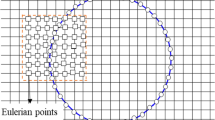Abstract
Droplet entrainment and deposition are a couple of significant mechanisms for the heat transfer in annular two-phase flows existing in some heat exchange systems. The basic physics include the peeling of droplets from the liquid film due to high friction with the gas phase and the collision of droplets with the liquid film or deposition into the liquid film. Droplet deposition particularly plays a crucial role in the course of film dryout events which might have a vital importance for particular systems. In this study, a new numerical method (named as VOF–MPS hybrid method) based on the moving particle semi-implicit (MPS) method was developed to analyze the droplet deposition onto a stagnant thin liquid film. That proposed method combines the volume of fluid (VOF) solver of the open-source CFD code OpenFOAM with the MPS method. VOF–MPS technique introduces the surface tension force calculation of VOF model into the MPS method. MPS method formerly employed the continuum surface force (CSF) approach based on the particles. Three-dimensional (3D) VOF–MPS simulation with the novel surface tension modeling addition to the MPS-based modeling provides a smoother liquid–gas interface on the crown formed after the impact. Droplet deposition experiments were also carried out for the validation and comparison of two models. VOF–MPS method could predict the crown parameters such as crown thickness relatively better than the MPS method employing the CSF. However, the instabilities formed at the tip of the crown, observed in the experiments, could not be resolved with both methods.
Graphical Abstract











Similar content being viewed by others
References
Azzopardi BJ (1997) Drops in annular two-phase flow. Int J Multiphase Flow 23:1–53
Brackbill JU, Kothe DB, Zemach C (1992) A continuum method for modeling surface tension. J Comp Phys 100(2):335–354
Eastoe J, Dalton JS (2000) Dynamic surface tension and adsorption mechanisms of surfactants at the air–water interface. Adv Colloid Interface Sci 85(2):103–144
Harlow FH, Shannon JP (1967) The splash of a liquid drop. J Appl Phys 38:3855–3866
Hirt CW, Nichols BD (1981) Volume of fluid (VOF) method for the dynamics of free boundaries. J Comput Phys 39(1):201–225
Ishii M, Grolmes MA (1975) Inception criteria for droplet entrainment in two-phase concurrent film flow. AIChE J 21:308–318
Ishii M, Mishima K (1989) Droplet entrainment correlation in annular two-phase flow. Int J Heat Mass Transf 32(10):1835–1846
Kataoka I, Ishii M, Nakayama A (2000) Entrainment and desposition rates of droplets in annular two-phase flow. Int J Heat Mass Transf 43(9):1573–1589
Koshizuka S, Oka Y (1996) Moving particle semi-implicit method for fragmentation of incompressible fluid. Nucl Sci Eng 123:421–434
Liu J, Koshizuka S (2005) Oka Y (2005) A hybrid particle-mesh method for viscous, incompressible, multiphase flows. J Comput Phys 202:65–93
Nigmatulin RI, Nigmatulin BI, Khodzhaev YD, Kroshilin VE (1996) Entrainment and deposition rates in a dispersed-film flow. Int J Multiph Flow 22(1):19–30
Paras SV, Karabelas AJ (1991) Droplet entrainment and deposition in horizontal annular flow. Int J Multiph Flow 17(4):455–468
Rieber M, Frohn A (1999) A numerical study on the mechanism of splashing. Int J Heat Fluid Flow 20:455–461
Weiss DA, Yarin AL (1999) Single drop impact onto liquid films: neck distortion, jetting, tiny bubble entrainment, and crown formation. J Fluid Mech 385:229–254
Weller HG, Tabor G, Jasak H, Fureby C (1998) A tensorial approach to computational continuum mechanics using object-oriented techniques. Comput Phys 12(6):620–631
Xie H, Koshizuka S, Oka Y (2004) Numerical simulation of liquid drop deposition in annular-mist flow regime of boiling water reactor. J Nucl Sci Technol 41(5):569–578
Yarin AL, Weiss DA (1995) Impact of drops on solid surfaces: self-similar capillary waves, and splashing as a new type of kinetic discontinuity. J Fluid Mech 283:141–173
Yoon SS, Hewson JC, DesJardin PE, Glaze DJ, Black AR, Skaggs RR (2004) Numerical modeling and experimental measurements of a high speed solid-cone water spray for use in fire suppression applications. Int J Multiph Flow 30:1369–1388
Author information
Authors and Affiliations
Corresponding author
Rights and permissions
About this article
Cite this article
Erkan, N., Kawakami, T., Madokoro, H. et al. Numerical simulation of droplet deposition onto a liquid film by VOF–MPS hybrid method. J Vis 18, 381–391 (2015). https://doi.org/10.1007/s12650-014-0241-2
Received:
Revised:
Accepted:
Published:
Issue Date:
DOI: https://doi.org/10.1007/s12650-014-0241-2




